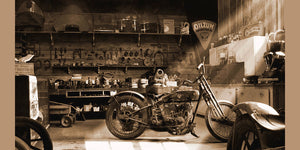Your Best Motorbike Shop for Top Quality Parts and Accessories
Your Best Motorbike Shop for Top Quality Parts and Accessories
Blog Article
Comprehending the Vital Parts of a Bike: A Comprehensive Guide for Enthusiasts
For motorbike fanatics wanting to boost their riding experience and guarantee their bikes run smoothly, comprehending the essential parts of a motorcycle is extremely important. Each aspect, from the engine's elaborate operations to the important function of the stopping mechanisms, not only impacts performance however likewise security and comfort. This guide will certainly stroll through the fundamental components that every rider ought to be acquainted with, allowing notified selections in both upkeep and possible upgrades. As we start this expedition, one must ask: how does each element connect to produce the smooth adventure every enthusiast seeks?
Engine Elements

The camshaft plays an important duty in managing the timing of the engine's valves, making certain the accurate opening and closing essential for efficient gas and air intake, in addition to exhaust expulsion. This timing is crucial to keeping ideal engine efficiency and efficiency. In addition, the carburetor or gas injection system, relying on the motorcycle design, is accountable for mixing air with fuel in the proper ratio for burning.
The cooling system, either air or liquid-based, works to preserve the engine's temperature level within functional limits, preventing getting too hot and making sure longevity - moto parts nz. Each element, diligently created and incorporated, adds to the smooth operation of the engine, defining the bike's power output and general efficiency
Transmission System
Integral to the motorbike's performance, the transmission system ensures efficient power transfer from the engine to the wheels. This system makes up a number of essential components, consisting of the clutch, transmission, and last drive, each playing an important function in converting the engine's power right into activity. The clutch, normally operated by a hand lever, serves to disengage the engine and engage from the transmission, permitting smooth gear modifications and regulated acceleration.
The gearbox, often described as the transmission appropriate, contains a set of gears that cyclists can by hand move with to readjust the bike's rate and torque result. These equipments are set up in a sequence that enables the motorbike to accelerate smoothly and keep optimum engine performance across various rates. A lot of bikes use a sequential gearbox, needing the motorcyclist to shift gears in a fixed order.
Braking Devices
While understanding the transmission system is vital to using a motorbike's power, similarly essential is the ability to regulate and stop that power effectively, which is where braking mechanisms come right into play. Brakes are vital for security and performance, offering the biker with the necessary control to browse different surfaces and problems. Generally, motorbikes feature 2 sorts of stopping systems: disc brakes and drum brakes.
Disc brakes are a lot more prevalent in modern-day bikes due to their remarkable efficiency. This system supplies much better warmth dissipation, regular performance, and enhanced quiting power, particularly in damp problems.
On the other hand, drum brakes, though less typical, are still located in some motorcycles. They work by pressing brake footwear versus the internal surface area of a drum attached to the wheel. While typically less efficient in warm dissipation advice and quiting power, drum brakes are simpler and a lot more cost-effective.
Comprehending these braking systems' nuances enables bikers to maintain their motorbikes effectively and appreciate the engineering that guarantees effective and risk-free stopping.
Suspension and Steering
Suspension and steering systems are essential parts that dramatically influence a motorbike's handling and experience convenience. The shock absorber, including forks at the front and shock absorbers at the back, soaks up roadway irregularities, improving security and control. Front forks, upside down or commonly telescopic, compress and rebound to reduce effects, while rear shock absorbers keep tire contact with the roadway, important for traction and security.
Steering, centered around the handlebars, links the cyclist to the bike's directional control. The steering head bearings make certain smooth operation, permitting accurate maneuverability. Proper positioning and upkeep of these bearings are essential for foreseeable steering response and reducing rider tiredness.
The suspension's adjustability is another vital aspect; preload, damping, and rebound setups enable customization to fit numerous riding designs and problems. This flexibility is crucial for optimizing performance, whether navigating city streets or tackling rugged trails. Innovations like electronic shock absorber offer real-time adjustments, boosting experience top quality throughout diverse terrains.

Electrical Solutions
After ensuring a smooth and controlled ride through effective suspension and steering systems, attention turns to the electric systems, a pivotal element of contemporary bikes. These systems play an important function not just in starting the engine however also in powering numerous elements that enhance the capability and safety of the bike.
At the heart of a motorbike's electrical system is the battery, which shops electrical power needed for beginning the engine and powering supporting systems - motocross parts nz. The generator or generator, paired with the rectifier-regulator, ensures the battery stays billed while the motorbike functions, transforming mechanical power into electric power and keeping voltage degrees
The ignition system, an additional important component, is responsible for sparking the air-fuel mixture in the engine's cylinders. Modern motorcycles typically make use of an electronic ignition system, supplying greater effectiveness and integrity compared to standard systems.
Illumination systems, consisting of fronts lights, tail lights, and indicators, are likewise important, making sure presence and safety and security for the motorcyclist. Added electronic parts such as sensing units, control units, and shows contribute to sophisticated attributes like gas injection monitoring, anti-lock stopping systems (ABDOMINAL), and digital dashboards, better improving the riding experience.
Verdict
A complete understanding of a motorcycle's crucial components, consisting of the engine, transmission system, braking devices, suspension, steering, and electric systems, is vital for lovers aiming to maximize comfort, efficiency, and safety. Mastery of these elements enables informed decisions pertaining to maintenance and upgrades, eventually enhancing the riding experience. By incorporating this expertise, bikers can ensure their motorcycles run at peak effectiveness and integrity, thereby Clicking Here making the most of both enjoyment and durability of their automobiles.
For motorbike fanatics looking to raise their riding experience and guarantee their bikes run a fantastic read efficiently, recognizing the essential components of a motorbike is critical.Indispensable to the motorbike's capability, the transmission system ensures efficient power transfer from the engine to the wheels.While recognizing the transmission system is key to utilizing a motorcycle's power, just as crucial is the ability to control and quit that power successfully, which is where stopping devices come into play. Usually, motorcycles include two types of braking systems: disc brakes and drum brakes.
An extensive comprehension of a motorcycle's vital parts, consisting of the engine, transmission system, braking mechanisms, suspension, steering, and electrical systems, is crucial for enthusiasts aiming to enhance efficiency, comfort, and safety and security.
Report this page